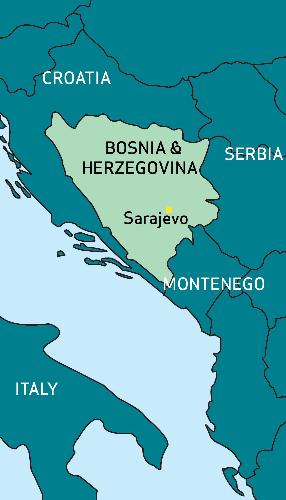
With a recent facelift reviving the once war-torn streets and a new BA flight to get you there, there's never been a better time to visit the capital of Bosnia and Herzegovina
Sarajevans love to walk. And the best way to experience the city is to... well, do as the Romans do. Walking through Bosnia and Herzegovina's capital is really a stroll through time: two days here and you'll see two millennia's worth of sights.
Start at the fountain in Sebilj Square. Also known as pigeon square, this has been a meeting point since the 15th century. It was here in Bascarsija, the heart of the old town, that caravans from Muslim Asia Minor and Christian Dubrovnik met to trade their wares. The city soon became a bustling trading centre and quickly expanded to accommodate the growing number of copper, leather, gold and silversmiths.
Today's old town maintains the flavour of those times. Spend the morning exploring the little side streets dedicated to those generations-old skills; Kazandziluk is the most famous, where coppersmiths continue to bang out beautiful Ottoman-style coffee and tea sets by hand. One of Bascarsija best-kept secrets is Male Daire, just 20m east of Sebilj; settle down in Halvat Café here - a tiny but charming oriental tea shop, perfect for a mid-morning cuppa.
Bascarsija really knows how to stir your senses with its aromas of fresh-roasted coffee beans and spice shops - and the sensory temptations don't end there. The locals are adamant that you haven't visited Sarajevo if you haven't indulged in their c´evapi. These speciality lamb and beef sausages have been known to lure even vegetarians hungry for a taste of Bosnia's high-quality, free-range traditional meat dishes. Head to Zeljo for lunch and see if you agree.
In the afternoon walk along Ferhadija. This walkway is both the lifeline and the timeline of the city: East literally meets West at this point. Extending out from Bascarsija, the city transforms from quaint Oriental trading quarter into a modern and lively Vienna-style shopping thoroughfare. Just a block west of Gasi Husrev Begova Mosque - the most significant Islamic structure in Sarajevo (and one open to visitors) - the feel of the city starts to change. It was here, in the late 19th century, that the Austro-Hungarians built the city's administrative centre and endowed it with its own rich architecture. The National Theatre on Branilaca Sarajeva street was built during this time and hosts MESS, the longest-running alternative theatre festival in the Balkans.
For a pick-me-up, head to Café Escobar in front of the cathedral - a great place to people-watch and enjoy a warming coffee. Just a stone's throw from the cathedral is Trg Oslobodenja, a large square that is home to the main Orthodox church; the National Gallery is on the southern side, which hosts a permanent exhibition of Bosnia's most famous artists. On the ground floor of the National Gallery is one of Sarajevo's best cafés - Karabit, a local hangout for artists and writers. Aside from the fabulous coffee, it serves local beer and wines if you want to get into the early evening spirit.
There is also a great bookshop, so you can have a browse with your drink. Karabit often hosts live concerts and exhibitions and even organises a wine festival in the downstairs gallery.
West of the city centre, Tito's Yugoslavia drastically expanded Sarajevo - leaving classic socialist-era marks. However, to find Sarajevo's true added value, head into the mountains.
The highland settlements south of Sarajevo preserve the last of Europe's semi-nomadic, medieval lifestyles. The highest and most isolated village in the country, Lukomir, offers an authentic peek into ancient mountain cultures.
This tiny Muslim community is perched on the edge of the Rakitnica Canyon, which drops 800m into one of Europe's most diverse ecosystems. Spend a day hiking along its magnificent ridge; it's hard to judge which is more magical, the stunning natural surroundings or the hospitality of the locals.
One of the best treks is a six-hour circuit from the entrance of the canyon, at the village of Umoljani, to Lukomir and back. This hike has it all: mountain streams, waterfalls and awesome views of the heart of the Dinaric Alps. Once in the canyon, leave the modern world behind; in its place you'll find medieval mountain traditions and an array of wildlife. Keep your eyes peeled for bear, fox, chamois or eagle.
Sarajevo has been named the fastest-changing city in Europe. Exploring its teeming streets, you'll be mesmerised by the energy, but rest assured that old traditions die hard. Sarajevo remains a cultural crossroads, and it's the blend of diverse cultures that gives it its strength.
Tim Clancy is the author of Bosnia & Herzegovina (Bradt)